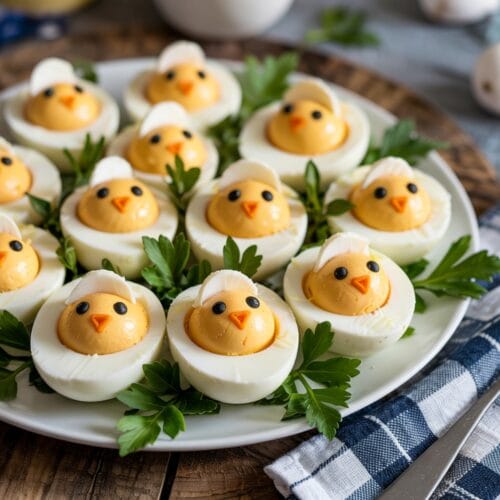
Chick Deviled Eggs
These Chick Deviled Eggs transform classic deviled eggs into adorable Easter appetizers by strategically cutting each egg to create a chick shape. The creamy yolk filling becomes the body while the egg white forms the head, with simple carrot beaks and olive eyes adding charming personality to these crowd-pleasing holiday treats.
Ingredients
For the Base
- 6 large eggs
- 3 tablespoons mayonnaise
- 1 teaspoon Dijon mustard
- 1/4 teaspoon white vinegar or fresh lemon juice
- 1/8 teaspoon salt
- Pinch of black pepper
- Pinch of paprika plus more for sprinkling
For Decorating
- 12 small pieces of carrots cut into tiny triangles for beaks
- 24 tiny pieces of black olives or capers for eyes
- Optional: Fresh dill or parsley sprigs for "nests"
- Optional: 2-3 whole black peppercorns for decorative eggs
Instructions
- Prepare perfect hard-boiled eggs. Place the eggs in a medium saucepan and cover with cold water by about an inch. Bring to a rolling boil over high heat, then immediately remove from heat, cover, and let stand for exactly 10 minutes.
- Cool them down. Transfer the eggs to an ice water bath and let them chill for at least 5 minutes. This makes them easier to peel and stops that unappealing gray ring from forming around the yolk.
- Peel with care. Gently tap each egg on the counter and roll it to create cracks all over, then peel under a thin stream of cold water to help remove the shell cleanly.
- Make strategic cuts. Pat the eggs dry with paper towels. Using a sharp knife, cut each egg in half lengthwise. For standard deviled eggs, you'd cut directly through the middle, but for our chicks, cut about 1/3 from the bottom and 2/3 from the top to create the chick's "body" (larger bottom piece) and "head" (smaller top piece).
- Extract the yolks. Carefully remove the yolks from both halves and place them in a small mixing bowl. Set the egg white pieces on your work surface, with the larger bottom pieces forming the bodies and the smaller top pieces forming the heads.
- Make it smooth and creamy. Mash the yolks with a fork until no large pieces remain. Add the mayonnaise, Dijon mustard, vinegar, salt, pepper, and a pinch of paprika. Mix until completely smooth and creamy. If the mixture seems too stiff, add a bit more mayonnaise, 1/2 teaspoon at a time.
- Fill those chicks. Spoon the yolk mixture into the larger bottom pieces of the egg whites (the "bodies"), mounding it slightly higher than the edge. Alternatively, use a piping bag with a round tip for a more polished look.
- Assemble your chicks. Place the smaller egg white pieces (the "heads") at an angle partially on top of the yolk-filled bottom pieces, pressing gently to secure them.
- Add personality. Insert small carrot triangles between the head and body to create beaks. Add tiny olive or caper pieces for eyes.
- Final touches. If desired, place your chicks on a bed of fresh dill or parsley "nests" on your serving platter. For extra Easter charm, add a few black peppercorns beside some of the chicks to look like little eggs.
- Serve with pride. Refrigerate until ready to serve, ideally within a few hours of assembly for the freshest presentation.
Notes
- For easier peeling, use eggs that are at least a week old rather than super-fresh ones.
- Adding a teaspoon of baking soda to the boiling water can also help make eggs easier to peel.
- For the smoothest filling, you can push the yolk mixture through a fine-mesh sieve before adding it to the egg whites.
- If making ahead, keep the egg white bases and filling separate in the refrigerator, then assemble just before serving.
- Wobbly chicks? Create a thin slice on the bottom of the "body" pieces to help them sit flat on the serving platter.
- For vibrant yellow filling, choose eggs with deeply colored yolks or add a tiny drop of yellow food coloring to the mixture.
- Keep refrigerated until serving to maintain food safety.